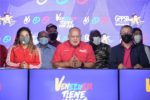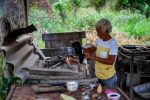
While the Venezuela government, notorious for its manipulation of statistics, claimed that the homicide rate dropped in 2013, to 39 per 100,000 of the population, a rather more reliable NGO puts the figure at more than double that, at 79, meaning the nation remains one of the most dangerous in the world.
According to statistics put together by the Venezuelan Observatory of Violence (Observatorio Venezolano de Violencia –OVV), murders significantly increased during 2013, with 24,763 registered homicides, bringing the country to yet another grim new record level of violence — 79 murders per 100,000 people. Last year, the Observatory put the rate at 73 per 100,000 compared to the government-cited figure of 56 per 100,000 — though even the lower, official figure was a record high for the country.
The 2013 rate of 79 murders per 100,000 would mean Venezuela is still far and away the most dangerous nation in South America, and trails only Honduras (with a rate of 86) as the most dangerous nation on earth.
InSight Crime Analysis
Unfortunately the government claims that homicides actually dropped 30 percent in 2013 are so unbelievable that they must be discounted. Ever since Hugo Chavez took power in 1999, the Venezuelan government has controlled the flow of information on all matters, but particularly that regarding public security. His successor, President Nicolas Maduro seems even divorced from reality. His grip of the tiller appears wobbly at best as inflation breaks 50 percent, there are frequent power outages and supermarket shelves lack basic products.
The reasons for the rapid increase in murders over the last decade in Venezuela are manifold. Perhaps first among them is the increase in drug trafficking through the country, with up to 200 tons of Colombian cocaine transiting every year, bound for the US and Europe. This has created not only organized crime networks but resulted in the widespread corruption of elements of the Venezuelan security forces — elements known as the “Cartel of the Suns,” after the gold stars that the generals wear on their epaulettes.
The Chavista regime has also promoted the creation of different irregular, armed groups, which began after the failed coup attempt against then president Hugo Chavez in 2002. Now the criminal landscape is populated with armed groups like the Bolivarian Liberation Forces (FBL) and the urban “colectivos” like the Tupamaros, which control large sectors of Caracas’ slums and whose activities are overlooked, or even supported, so long as they deliver votes for the government on election day.
The likelihood is that crime and violence will increase in Venezuela during 2014. It remains to be seen if Venezuela will topple Honduras from its position as the world’s most dangerous nation.
- Venezuela











